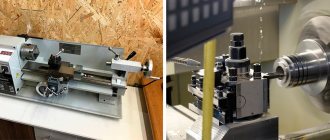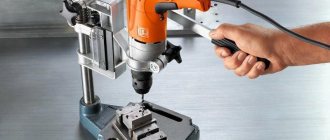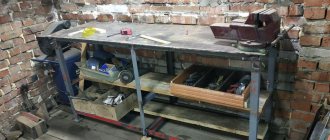Woodworking power tools can be classified according to the level and volume of work performed:
- professional;
- semi-professional;
- amateur.
Despite the popularity of polymers and metal in construction due to their practicality, durability and ease of use, wood adds a sense of comfort, coziness and peace of mind to any building, which is why many builders love to work with wood.
Among the woodworking tools there are manual, electric, and also “heavy artillery” - machines. In this article, we will focus on portable power tools for woodworking.
Nowadays, each woodworking operation has its own hand-held power tool; let’s look at them in more detail.
Variety of instruments
Wood processing refers to a large number of operations, and each of them requires its own tools. Wood can be sawed, drilled, planed, and objects of simple or intricate shapes can be cut out of it. The totality of all tools is divided into two groups:
- manual;
- electric.
In addition, they are divided into professional, amateur and intermediate categories. At home, it is most convenient to perform woodworking with amateur or semi-professional tools. In addition, their price is significantly less than professional ones.
Hand tool
Hand tools are those that require human physical strength to use. Since woodworking was done at a time when no one knew about electricity, all manipulations with wood can be done manually.
The ax is considered one of the most ancient in origin. It is still used at home - in many private households one cannot do without an ax.
There are hand saws, drills, chisels, planes and much more. They need to work carefully and skillfully. You can’t do it without proper practice and skills; you often need considerable physical strength.
Power tools
Electrical devices are easier to use. They allow you to complete the job several times faster and with less effort. Power tools for woodworking at home are available in mains-powered and battery-powered versions. When purchasing such units, you need to pay attention to their power, service guarantee and basic capabilities. Priority should be given to those functions that you plan to use most often.
It is worth noting that power tools can also be hand-held or stationary. Hand-held power tools for woodworking can be carried and performed while holding it in your hands. In the second case, the tool is fixed, human intervention is minimal, it is often a machine that can be a lathe, slotter, milling machine, or planer.
Sawing and planing of wood OKVED 2: code 16.10
OKVED is an all-Russian classifier of types of economic activity. This document includes the following stages of wood processing:
- Felling cleaning or splitting lumber.
- Manufacturing of wooden railway sleepers.
- Sawing and planing of wood, impregnation of wood with various chemicals to protect it from environmental influences.
- Mandatory drying of lumber.
- Production of unassembled flooring.
The All-Russian Classifier of Types of Economic Activities - OKVED for sawing and planing wood - is a document that also has several clarifying child codes. The main entry is located under code 16.10.
Wood sawing tools
You can cut wood or materials made from it using several types of tools:
- hacksaw;
- saw;
- jigsaw
All of them are manual and electric. The hacksaw is ideal for garden work; it is used to saw not too thick branches, boards, and blanks for carpentry.
When constantly sawing wood at home, it is simply necessary to have a circular saw (circular saw). It cannot make shaped cuts, but it cuts through boards, plywood, and some types of plastic as quickly as possible.
If you need to cut down trees or prepare firewood, then in this case you use chain saws. There are also hand saws for logging, which require two people to work with.
Use a jigsaw to cut out shapes of arbitrary shape. It is suitable for cutting out blank models, artistic panels, various crafts, furniture parts, and kitchen appliances.
Machine processing technology
When operating a jointer that has a manual feed, one worker is required. The worker takes the workpiece from the stack and assesses its condition. Lumber that is too warped should be discarded. If it is not very concave or warped, then it can be used; the product is placed on the table with the concave side. Next, the workpiece is pressed against the ruler with the left hand, and fed to the machine with the right hand. In this case, the end of the wood will push back the fan fence. This will open access to the shaft with rotating knives. When the front part is processed, it is necessary, still holding the workpiece with your left hand, to gradually push it forward with your right, at a uniform speed. In this case, of course, you need to keep your hands at a safe distance from the knives.
If a jointer with a mechanical feed is used, the lumber feed speed is calculated based on the maximum power of the electric motor. After processing, the product must be checked. Deviation from the plane is allowed no more than 0.15 mm for every 1000 mm. Deviation of adjacent surfaces is allowed no more than 0.1 mm at a height of 100 mm.
When using this tool for planing wood, it is very important to ensure that there are no defects or irregularities on the surface. If during operation the knife encounters such a defect, the workpiece may twitch, and the worker’s hand lying on the product may fall into the knife gap.
The most dangerous is planing wood that is quite thin, narrow or short. For this reason, if the machine has a manual feed, then there are restrictions on the dimensions of the workpieces. Length up to 400 mm, width up to 50 mm, thickness up to 30 mm.
Axes and splitting axes
From time immemorial, carpentry work has been performed with axes. They trimmed logs, made windows, doors, and built log houses with their help. Axes and cleavers are needed to split logs into firewood. An ax of a certain type is a military weapon.
Note! Splitting tools differ in size, shape of the metal part and handle, which is made of wood or fiberglass.
Today, electric splitters (wood splitters) are produced, which can quickly split logs of a certain length and diameter. Their cost is two orders of magnitude higher than ordinary high-quality axes.
Electric hacksaw
Also known as a reciprocating saw, and colloquially called an alligator saw
According to the principle of operation, it completely repeats the classic hand hacksaw, only the reciprocating movement is provided by electrical energy, and not by your hand.
Unlike a circular saw, a reciprocating saw is messier, slower and rougher, but it is safer to work with. However, the alligator also has advantages: the depth of cut, which is limited only by the length of the saw blade (and they are replaceable, so you can always find consumables for any task in the store), and the ability to work in hard-to-reach places.
What you need to know when choosing
- The blade speed adjustment parameter will allow you to select the optimal mode based on the hardness of the wood;
- The higher the power, the faster you will complete the task;
- The longer the blade, the thicker the board you can reach.
As the name suggests, it is needed for milling, namely chamfering, cutting quarters and cutting grooves and splines.
What to pay attention to
All the tools collected here are most often suitable not only for woodworking operations, but also for working with other materials: plastic, metal, plywood. You just need to choose the right consumable.
Planers for planing
Wood must be planed with a plane. It removes a thin layer of chips, allowing you to get an even, smooth surface. Neither a joiner nor a carpenter can do without a plane. They are used by craftsmen of musical instruments, furniture, dolls, kitchen utensils and much more.
Advice! When choosing an electric planer, pay attention first of all to its power, blade width and planing depth declared by the manufacturer.
It’s a good idea to have a whole set of planes, or at least one universal one. As you master the work of a carpenter or joiner, you will need other types of planes.
For rough planing, a bearer is used; for finishing, a jointer or semi-jointer is suitable; the removal of tongues and grooves is carried out with a tongue and groove tool. There are also scrapers, moulders, and many other highly specialized tools for planing.
Preparation for use
Preparation for work includes the stage of technical adjustment of the unit, as well as checking its performance. As for the technical setup, it is as follows. Knives that are installed on jointing machines must have a straight shape. Using a ruler and a feeler gauge, deviations from straightness are monitored. The gap allowed between the ruler and the blade is only 0.1 mm if the blade length is up to 400 mm. If the blade is up to 800 mm long, then the gap can be 0.2 mm. As with an electric planer, the knives must be balanced in weight. Installation of knives is carried out sequentially. The device has a chip breaker. Knife blades should protrude above this element by no more than 1-2 mm. To check the machine, it is necessary to have a test block, which is usually made of hard, dry, seasoned wood. It also has precision machined edges. The cross-section of the edges can be 20-30 x 50-70 mm and a length from 400 to 500 mm.
Grinding and roughening tools
To make wood perfectly smooth, you need a sanding tool. Small figures and wood parts are sanded manually with sandpaper and sandpaper, making monotonous mechanical movements.
To smooth the edges and ends of products, rasps are used. These are special files for wood with a large notch.
For large areas, electric woodworking machines are used, these include:
- grinders with grinding attachments;
- belt sanders;
- eccentric (orbital);
- surface grinding (vibrating).
A belt tool is more suitable for rough sanding, removing thick layers of paint or leveling a surface. Finer grinding is carried out using eccentric and surface grinding units.
Chisels and chisels for chiselling
Tenons and grooves in wood for connecting parts are made with chisels and a chisel. This is a hand tool. To hollow out a deep and wide enough socket or eye, use a chisel. The working part of the chisel is a steel block sharpened on one side.
Using a chisel, shallow holes are hollowed out, the surface of the wood is cleaned, and parts are adjusted. The shape of the chisel blade can be flat or semicircular.
Before starting work, markings are applied to the part, then it is firmly secured in a clamp on the workbench and they begin to hollow out. The fibers are cut at an angle of 45–60°, deepened each time by 4–5 mm, and the shavings are immediately removed.
Jointer
It’s worth considering the design of this machine from the fact that it can be single-sided or double-sided. If a double-sided machine is used, then two adjacent surfaces of one workpiece can be processed at once. There are also machines with manual feed or with mechanized feed. If with manual feeding everything is simple and clear, then for mechanical feeding it is necessary that an automatic feeder be installed nearby. In some cases, an integrated conveyor feed mechanism may be used instead. Also, these machines are equipped with devices such as chip collectors, which are used for chips and dust. It is connected to the factory exhaust network.
Drilling tools
Hand drills, rotary hammers, and augers are necessary for drilling holes. It is much easier to carry out woodworking with an electric drill. It will require special attachments.
There are a large number of types of nozzles, including countersink, center (perk), spiral, screw. A drill can be used to drill holes for bolts, tenons and other types of connections. By selecting a nozzle of the desired shape, you can expand the range of work performed.
Fraser
One of the important power tools for woodworking at home is a hand router. They use it to grind the edge, making it rounded and shaped, cut grooves, and drill holes. They produce various types of milling cutters with a wide and narrow spectrum of action. They differ in power, cutter shank diameter, and maximum rotation speed. In addition to wood, drywall, plastic, and acrylic are processed with a milling cutter.
Workplace and additional equipment
When carrying out woodworking work at home, you cannot do without clamps. They help to fix parts individually and among themselves during cutting, gouging, drilling, and gluing.
Other important tools in woodworking are pliers and nail pullers. They are used to remove nails and other foreign objects from wood.
During the woodworking process, it is important to properly prepare the workplace. For metalworking work you need a workbench. This is, first of all, a table at which it is convenient to perform various manipulations. The workbench also contains useful devices:
- front and rear screw clamps for fixing workpieces;
- holes for wedges into which the workpiece rests;
- tray for storing carpentry tools.
A rack is often installed near the workbench where the necessary equipment, materials, and templates are stored. You will need a comfortable chair. It is also necessary to take care of an outlet for connecting power tools and high-quality lighting.
Additional devices that any craftsman should always have on hand include rulers, protractors, levels, and squares. Most likely, you will need consumables (sandpaper, files, circles). Since a full production cycle is usually established in a home workshop, it is necessary to allocate space for varnish, paints, and brushes.
Any tools must be in good condition. If a breakdown occurs, they are restored as quickly as possible or removed to a place where they will not interfere.
Electric chisel
The classic hand chisel was recently replaced by an electric analogue. The wooden handle was replaced with a plastic case in which the electric drive is hidden. The device has a power button, an indicator of operating and locking modes, as well as a nozzle lock.
Very often, an electric chisel is called an electric scraper or an electric chisel. It combines many functions and allows you to perform a large number of jobs:
- removing old coating, traces of technical fluids or adhesive base from the surface;
- performing, including the most miniature, wood carvings;
- complete or partial removal of the thin top layer from the material being processed.
The main advantage of this tool is its versatility. Thanks to the power control system, both rough processing of the material and fine finishing, including wood carving, are performed. The downside is that during work you need rest periods to cool down. Working surfaces require regular sharpening.
Electric chisels perform both rough processing of material and fine finishing, including wood carving.
When choosing a chisel, decide what and how often it will be used. If from time to time, a device with a minimum number of functions is sufficient. For frequent professional activities, a powerful, multifunctional device with a large number of attachments is suitable.
For small jobs, a miniature device is suitable; for large, large-scale jobs, the tool must match.
But in all cases, when choosing, they focus on:
- The body must be light and strong, without loose parts.
- The tool should fit comfortably in your hand.
- The presence of a lock button and a regulator of operating modes is mandatory.
- The attachments should be held tightly in the retainer and can be easily removed.
- Nozzles must be made of durable steel.
The manufacturer also plays an important role in choosing an electric chisel. Below are the main companies and the characteristics of their tools.
- Makita TM 3000С
Electric chisels have a proprietary set of attachments that allow you to perform a wide range of work. The tool is easy to use. There are practically no vibrations in the body. Has 12 fixed positions for interchangeable attachments. It has a power of 320 W, engine rotation speed is from 6000 to 20000 rpm. The package includes a chip remover with a vacuum cleaner.
Prices fluctuate around 13,000 rubles.
- Bosch Pmf 190 e set – 7489
It is characterized by the accuracy of the work performed, minimal noise and vibration. Ideal for household chores. Convenient, lockable start button. The attachment of the attachments at different angles to the device is reliable and does not allow slipping. Power 190 W, motor rotation speed from 15,000 to 21,000 rpm. Includes 2 segmented and 3 immersion elements, a set of sandpapers, a mounting screw and a key.
The cost is around 8000 rubles.
- Skil Masters 1490 NA – 4850
Designed for finishing wood, plastic, metal and drywall. Allows you to sand difficult areas. Has a speed control function. It is characterized by low weight and a comfortable key. Power 220 W, engine rotation speed from 12,000 to 19,000 rpm. It has a set of replaceable attachments, a sanding pad, a set of sandpapers, and a key.
Price 4500 – 5000 rub.











